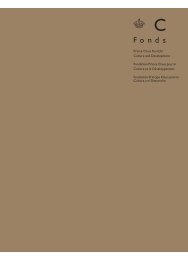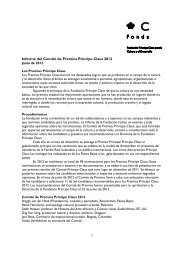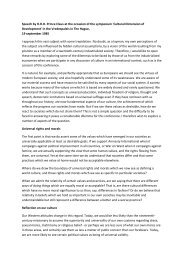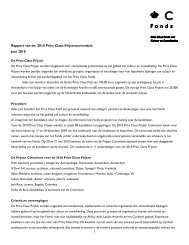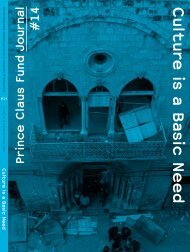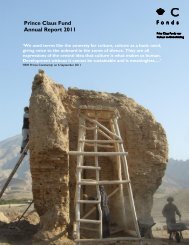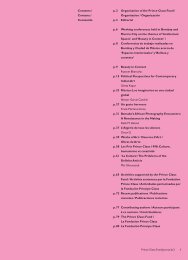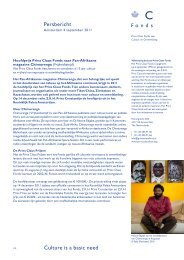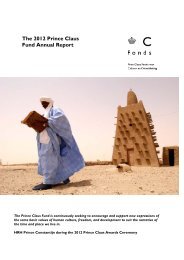3 summer 2011 - Prince Claus Fund
3 summer 2011 - Prince Claus Fund
3 summer 2011 - Prince Claus Fund
- No tags were found...
Create successful ePaper yourself
Turn your PDF publications into a flip-book with our unique Google optimized e-Paper software.
30–053talattekin_alt:turklergaram 29.11.2007 9:21 Uhr Seite 31LANGUAGE AND IDENTITYPresent-Day Turkic Peoples andTheir LanguagesTALAT TEK‹NA young Mongolianhorseman stands beside thepillar containing theeighth-century TonyukukInscriptions, chiseled withinvaluable observationsabout the lives and battlesof Turkic-speaking peoplesduring that era.Before embarking upon the main topic, I would like topoint out that there are several Turkic languages—in fact, oneshould speak of a “family” of Turkic languages. For a long time,these languages, all descended from an Ur-language in thedistant past, have been referred to in English as “Turkic” languages.The term Turkish, which has long existed in English, isnow used to refer only to the Turkish language employed incontemporary Turkey.At the present time, Turkic languages are spoken over avery wide area stretching from the Pacific Ocean and the Seaof Okhotsk in the east to the Baltic Sea on the west, and fromthe shores of the Arctic Ocean in the north to Basra and theshores of the Persian Gulf in the south. These Turkic languages,which are located quite closely together in Central Asia, arevery widely separated in other areas. Speakers of Turkic andrelated languages number some 135 to 140 million.Until quite recently, Turkic languages were classified insix broad categories: (1) The South-West or Oghuz group, (2)the North-West or Kipchak group, (3) the South-East orChaghatay group, (4) the North-East or Altai Tuva-Abakangroup, (5) Yakut, and (6) Chuvash. The German TurcologistGerhard Doerfer, who discovered a Khaladj language spokenin central Iran displaying certain archaic characteristics, addedthis language as a seventh group.In our opinion, the application of phonetic principles inthe classification of these Turkic languages will lead to the creationof twelve separate groups: (1) Chuvash (r- and il-di: tıhhır“nine,” hil “winter”), (2) hadak group (Khaladj), (3) atax group(Yakut and the Dolgan dialect), (4) adak group (Tuva and Tofadialect), (5) azak group (Khakas; Middle Chul›m, Mrass, andUpper Tom dialects), (6) ayak/tağliğ group (Northern Altaidialects: Lower Chulym, Kondom, and Lower Tom dialects;Yellow Uighur, Fu-yü Kirghiz), (7) ayak- and tu:lu (written Altaidialect), (8) ayak and to’lu group (Kirghiz), (9) ayak and tağlik(Chaghatay) group (Uzbek, New Uighur), (10) ayak and tawli(Kipchak) group (Tatar, Bashkir, Kazakh, Karakalpak, Nogay,Kumuk, Karachay-Balkar, Karay or Karaim, Crimean Tatar,Baraba Tatar, the Khwarezm-Kipchak dialects of Uzbek), (11)ayak and tağlı group (Salar dialect or Salar language), (12) ayakand dağlı (Oghuz) group (Turkmen, Trukhmen dialect; Khorasandialect; the Khwarezm-Kipchak dialects of Uzbek; Azeri orAzerbaijani Turkish; Kashkay, Eynallu, Kirkuk, and Erbil dialects;Gagauz Turkish).Of the twenty-four Turkic languages and dialects, twentyare written languages. From near to far, these are: Turkish,Azeri or Azeri Turkish, Turkmen, Kumuk, Karachay-Balkar,Nogay, Crimean Tatar, Gagauz, Tatar, Bashkir, Chuvash, Kirghiz,Kazakh, Karakalpak, Uzbek, Uighur, Altai, Khakas, Tuva, andYakut. The following are Turkic languages and dialects withouta written component: the Yellow Uighur spoken in China’sKansu Province; the Salar spoken in the Xunhua SalarAutonomous County of China’s Qinghai Province; the Chul›mTatar spoken in western Siberia; and Khaladj, the archaic Turkiclanguage recently discovered in central Iran. To these dialectsmay be added Shor and Baraba Tatar— both of which lack awritten component—spoken in Siberia. It would, however, bemore reasonable to accept Shor as a dialect of written Khakasand Baraba Tatar as a written dialect of Tatar. As for ChulymTatar, there are two dialects of this language: (1) Middle Chul›m,(2) Lower Chulym. As a /z/ dialect (azak “foot”), Middle Chul›mis close to Khakas and may be regarded as a dialect; as a /y/dialect (ayak), Lower Chulym combines with the Northern Altaidialects (Kondom and Lower Tom) to form the tağlığ group ofTurkic dialects.In the various Turkic languages and dialects spokennowadays, mutual intelligibility ranges from zero to 75 or 80percent. For example, Chuvash has a mutual intelligibility ratioof zero with all the other Turkic languages, and the same canbe said of Yakut, Tuva, and Khakas; between Turkish and Azeriand Gagauz Turkish, there is a fairly high mutual intelligibility3141 · <strong>Prince</strong> <strong>Claus</strong> <strong>Fund</strong> Reader #3 · Summer <strong>2011</strong>



